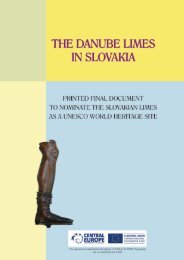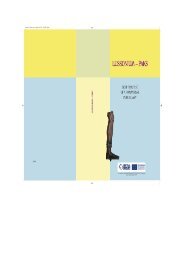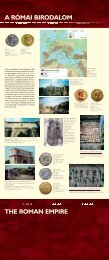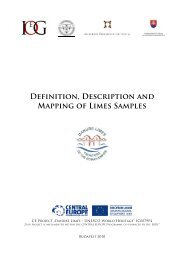the PDF version! - Danube Limes
the PDF version! - Danube Limes
the PDF version! - Danube Limes
You also want an ePaper? Increase the reach of your titles
YUMPU automatically turns print PDFs into web optimized ePapers that Google loves.
Frontiers of <strong>the</strong> Roman Empire – Ripa Pannonica in Hungary (RPH) Nomination statement<br />
<strong>the</strong> border in Barbaricum. This Empire that stretched over three continents developed <strong>the</strong> Greco-Roman<br />
world culture in this part of Europe, and fur<strong>the</strong>r disseminated it. The uniform arrangement of <strong>the</strong> Roman<br />
Empire, its common language and last but not least <strong>the</strong> movement of soldiers on <strong>the</strong> borders and between<br />
<strong>the</strong> most distant areas established <strong>the</strong> medium through which Christianity suddenly proliferated,<br />
providing <strong>the</strong> foundation for <strong>the</strong> future of Europe. In addition to <strong>the</strong> archaeological remains, its impact,<br />
which stretches far beyond <strong>the</strong> period that <strong>the</strong> Empire existed, is clearly evident to <strong>the</strong> present day in <strong>the</strong><br />
spatial organization of towns and regional systems of roads as well as economic and cultural borders.<br />
3.b.2 Outstanding Archaeological Value<br />
The Ripa Pannonica is a section of <strong>the</strong> several thousand mile border of <strong>the</strong> Roman Empire, which as a part<br />
of a whole exhibiting outstanding universal value naturally does not only share in this universal value, but<br />
contributes to its broadening and enhancement through its own particular features.<br />
From a historical standpoint <strong>the</strong> Ripa Pannonica and <strong>the</strong> armies stationed <strong>the</strong>re, which made up <strong>the</strong><br />
main strength of <strong>the</strong> Danubian army – within <strong>the</strong> three big military concentrations in <strong>the</strong> West, in <strong>the</strong><br />
East and in <strong>the</strong> middle of <strong>the</strong> empire <strong>the</strong> largest military force – acquired extraordinary significance.<br />
This army obtained <strong>the</strong> throne for Vespasian in 69 AD and for Septimius Severus in 193. Both of <strong>the</strong>se<br />
emperors founded dynasties and so <strong>the</strong> reign of <strong>the</strong>ir families ensured that particular attention was paid<br />
to Pannonia for a long time. Our area enjoyed a similarly exceptional appreciation under <strong>the</strong> later Illyrian<br />
emperors, including Aurelian and Diocletian. They succeded to reunite <strong>the</strong> empire which had splitted<br />
to more parts in <strong>the</strong> turbulent decades of <strong>the</strong> third century. Also <strong>the</strong> Constantinian and Valentinian<br />
dynasties originated from <strong>the</strong> Balcanic provinces.<br />
Crucial events and battles took place in Pannonia’s lands, which impacted and determined <strong>the</strong> fate of not<br />
only <strong>the</strong> province, but of <strong>the</strong> entire empire. Marcus Aurelius was victorious over <strong>the</strong> Germanic peoples in<br />
Pannonia and foraying out from Pannonia in <strong>the</strong> 170s. On many occasions it was here that <strong>the</strong> forces of<br />
<strong>the</strong> western and eastern empire clashed, between Ingenuus and Gallienus in 258, Licinius and Constantine<br />
in 314 and Magnentius and Constantius II in 351. During <strong>the</strong> time of <strong>the</strong> tetrarchy a Pannonian city,<br />
Sirmium, became an imperial seat and it retained its special position for several decades.<br />
The Ripa Pannonica enriches <strong>the</strong> universal value of <strong>the</strong> Roman limes World Heritage site with many unique<br />
archaeological elements. In addition to it being <strong>the</strong> longest riverside limes section in <strong>the</strong> nominations for<br />
<strong>the</strong> World Heritage, it should also be pointed out that it is here where <strong>the</strong> limes road has been <strong>the</strong> most<br />
thoroughly researched and included in <strong>the</strong> nomination up to this point. The sections of road that have been<br />
examined and mapped also show that <strong>the</strong> limes road was built according to <strong>the</strong> classic traditions of Roman<br />
road construction, and its path has been determined with precise geodesic measurements. As a result of this,<br />
<strong>the</strong> Roman military road is divided up into absolutely straight sections that are 5-10 or even 20 km long.<br />
A prominent characteristic of <strong>the</strong> Ripa Pannonica is that through <strong>the</strong> means of archaeology four centuries<br />
of history and border defense can be examined, studied and marveled at along its path. The <strong>Danube</strong><br />
formed <strong>the</strong> border of <strong>the</strong> province and <strong>the</strong> empire starting from its conquest by Augustus until <strong>the</strong> 430s<br />
when it was abandoned, so it has an outstanding ability to represent <strong>the</strong> long historical development of<br />
Roman border defense.<br />
The various military structures on <strong>the</strong> riverside limes were continuously built up starting from <strong>the</strong> middle of<br />
<strong>the</strong> 1 st century. Archaeological investigations have successively shown <strong>the</strong> changes that occurred in border<br />
49











